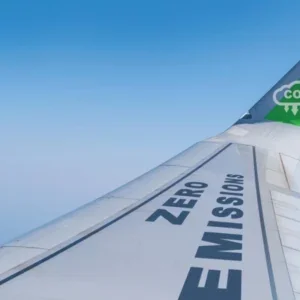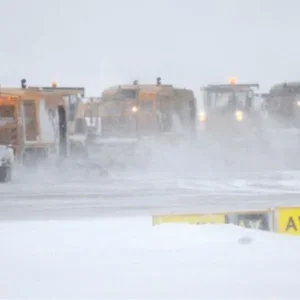Every day around the world, air traffic controllers use their skills and sophisticated technological tools to safely bring around 100,000 aircraft safely on to the tarmac. Most use static visual cues to ensure the correct separation of aircraft by distance on final approach. Now, however, at London Heathrow, the UK’s busiest airport, they no longer separate aircraft by intervals of distance but by intervals of time instead.
At an airport running at 98% of its theoretical capacity all day, every day, and where a landing or take-off occurs every 45 seconds, any delay can cause a ripple effect that is hard to recover from. There are no natural ‘firebreaks’ in the schedule, so there has been great pressure to improve the air traffic control function. The new time-based separation (TBS) system, which works on a deeper understanding of the wake-vortex characteristics of different aircraft in different wind conditions, is the response to that pressure.
“If there is a strong wind, the capacity of the runway drops, and this typically accounted for 44% of delays into Heathrow before TBS was in operation,” says Andy Shand, general manager – customer affairs at NATS. “For example, with distance-based separation, if there is a medium-category aircraft, such as a 737 or A320, behind a heavy-category aircraft, a 777 or A340 say, you need to have five miles between them. If a heavy aircraft is following a heavy aircraft, then the gap is four miles.
“With a headwind of 5–7kt, it takes a heavy aircraft 90 seconds to cover four miles. But with a headwind of 35kt, it takes the aircraft 107 seconds to cover that same distance – effectively losing 17 seconds’ worth of runway capacity per arrival. With TBS, we can keep that 90-second gap constant in all wind conditions by dynamically adjusting the distance between arrivals.
“For example, with TBS and a 35kt headwind, the distance between two heavy aircraft would be 3.4 miles, and that is safe to do because the wake vortex dissipates faster in headwinds – TBS dynamically adjusts the spacing according to actual wind conditions. It works the other way, too: if there is no wind or only light wind, then the risk from the wake vortex is greater, so the tool increases the gap between the aircraft. TBS improves not only efficiency but also safety,” he adds.
Data-driven decisions
NATS is the UK’s sole provider of en-route services and handles 2.3 million flights carrying 250.0 million passengers in UK airspace each year. It began the development of TBS by collating data from Heathrow over a five-year period, covering 150,000 flights in all wind conditions. It looked closely at the behaviour of the wake vortex at landing, comparing in-ground effect with out-of-ground effect, and proved that wake vortices dissipate faster in higher winds.
“That was when we knew we could build the safety case for TBS,” explains Shand. “We then had to build the capability, so we went to the airlines and the airport, which were keen to invest. Lockheed Martin is our technology partner, and we worked with all of these stakeholders with an agile approach to the development of the tool.
“We looked into one big risk at a time, building prototypes early on and getting feedback from ATC, the regulator and the operators. The tool was delivered 18 months later and went live in early 2015.”
The headwind delays Heathrow was experiencing were equivalent to as much as 180,000 minutes a year, and were the biggest single cause of arrival delay and flight cancellations. Since its introduction, TBS has enabled Heathrow to achieve a reduction in delays caused by headwinds of well over 50%. In November 2015, the windiest month of that year, the airport saved more than 25,000 minutes of potential delay.
Catch the wind
TBS is a world first in aviation, and its development depended on the ability to harness highly accurate data about wind conditions. The system uses live wind data to dynamically calculate the optimal safe spacing between aircraft in order to maintain the landing rate.
“We can’t use forecast data, so we download data from the aircraft,” says Shand. “Through Mode S, we get data on heading, ground speed, airspeed and other parameters that we can use to accurately calculate wind speed. We tested that for a year, and we had an error rate of only 0.006%, which is very good. The Glideslope Wind Conditions Service is part of TBS.
“We also need to know the sequence of the aircraft, so we have an algorithm that follows aircraft as they vector in for final approach. Once we knew the aircraft type, the sequence, the wind conditions and the rules, we needed to develop an interface. The controller sees dynamic lines that are assigned to each aircraft and that move down through the approach. These lines show how close aircraft can be.”
From its earliest deployment, the system showed great promise. In January 2015, it was launched in shadow mode at the NATS operations room in Swanwick, which combines the London Area Control Centre, the London Terminal Control Centre and Military Air Traffic Control. A few weeks later, it began operating in distance-based mode, before going live in March. It was fully signed off in May last year.
“In the first two days of operation, we had very light winds, so everything seemed the same as before. Later that month, however, we had 55kt winds at 3,000ft on final approach. That week, we saved 10,000 minutes of delay and there were zero cancellations due to wind. I was flying into London that week, and there were delays all over Europe, but I arrived at Heathrow five minutes early,” notes Shand.
“We analysed the 2015 data for May–July and found that, in all wind conditions, we gained on average 1.2 additional landings an hour and 2.9 more in high winds. That adds up at an airport that is operating all day, every day. During Storm Barney last year, when we had 60kt winds at 3,000ft, we landed up to an additional five aircraft an hour compared with when we used distance-based systems. Now, wind-related delays are down by over 50%. We have recovered 20 landings a day in all wind conditions.”
A new platform for innovation
It is estimated that, during its first full year of operation, TBS will enable savings of 80,000 minutes of delay at Heathrow, which equates to more than £6 million in delay savings for airlines. The system has performed so well – and the transition for controllers, pilots and aircrew has been so smooth – that NATS and its partners are already looking at the next iteration of the technology. The natural first step is to take the information provided by the TBS tools – collectively known as ‘Intelligent Approach’ – to a more granular level.
“There are currently six wake-vortex categories ranging from superheavy to light,” says Shand. “The key is that the aircraft types that are grouped into a particular category do not all generate the same wake vortex, so you could optimise the system for individual aircraft types.
That is in development now, and it could lead to two or three more movements an hour, which would be a massive gain. It would be relatively easy technically to build on to the tool, but we need to work out the safety case, and this is currently in R&D.
“With mixed-mode runways that handle arrivals and departures, we usually separate aircraft by six miles to leave a gap for a departure but, again, different aircraft have different characteristics. A 747 needs that gap as it has longer runway occupancy, but an A320 accelerates faster so needs less time,” Shand continues.
“We can tell the tool about the departure aircraft type and runway occupancy required, and tailor gaps on final to match it. We have simulated it and proven that we can do it. At some airports, that could add an additional two movements an hour.”
There is also potential for optimising the separation of aircraft that land on parallel and converging runways. In these instances, Intelligent Approach could play a major role in improving safety by highlighting any conflict and efficiently delivering an increase in runway capacity.
“We are doing work on each of those applications now and have built the algorithms; they are all part of the development roadmap,” says Shand.
In the immediate future, however, the main goal will be to roll out TBS at other airports. The EU has mandated TBS for 17 airports by 2024, and the modular design of the system ensures it can be easily adapted to different runway configurations and ATC operating methods. Shand is not surprised by the growing interest from airports around the world – even those outside the EU mandate – because TBS has proven its worth so quickly.
“There is a strong case for efficient air traffic management and a strong case for improvement in safety. It brings benefits to airlines, air traffic controllers, airports and passengers. One year on, we have the data to prove that it works very well.”






